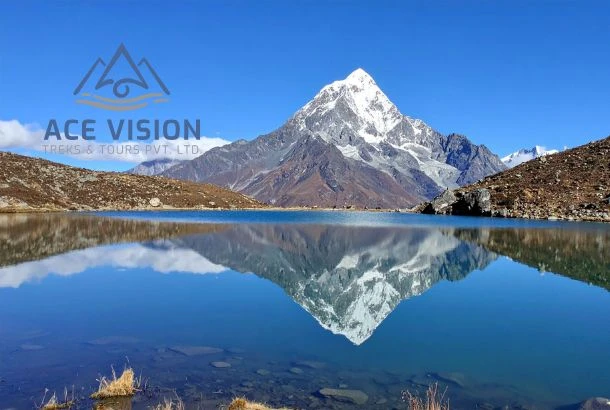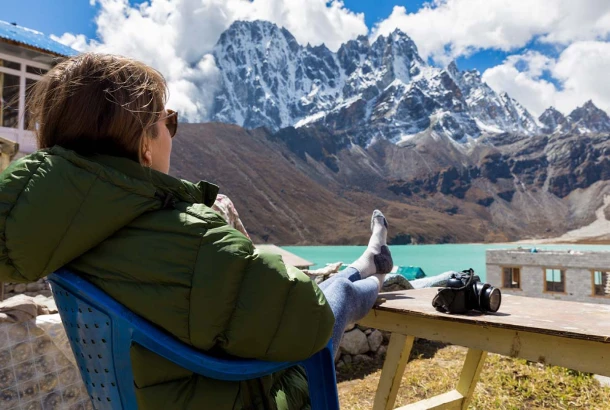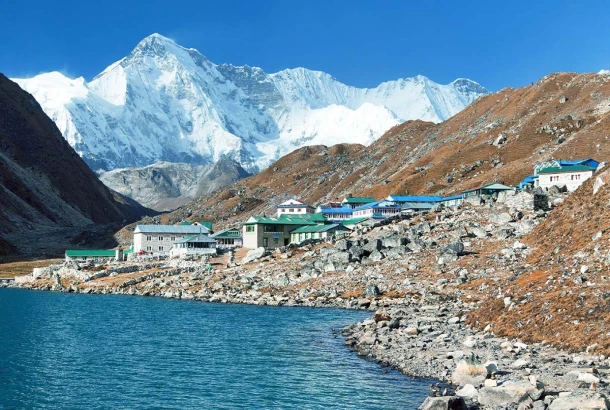Quick Facts: Manaslu Circuit Trek in October |
|---|
Feature | Details |
Average Daytime Temperature | 10°C – 20°C (lower elevations) |
Average Nighttime Temperature | -5°C – 5°C (high elevations) |
Difficulty Level | Moderate to Hard |
Total Duration | 14–17 days |
Highest Point | Larkya La Pass, 5,160 m |
Typical Trek Start Point | Soti Khola or Arughat |
Permits Required | Restricted Area Permit (RAP), Manaslu Conservation Area Permit (MCAP) |

Manaslu Circuit Trek: October Highlights
- Providing a balanced trekking experience between weather, scenery and culture is a major highlight of trekking in October.
- The sky remains brilliantly clear, so that peaks like Manaslu, Himalchuli, and Ganesh Himal can be seen clearly and beautifully during the journey.
- The days feel comfortably warm and pleasant, which makes the trail simple and more enjoyable.
- The trails remain dry and stable, which makes it safe and easy to trek.
- The villages are decorated due to Dashain and Tihar. People celebrate several cultural programs, which give trekkers a chance to enjoy and observe the local culture.
- Almost every lodge and teahouse is open and welcoming. So, getting food and accommodation is easy.
- October brings many trekkers from all over the world. So, an atmosphere of warmth and connection is created among trekkers.
- Crossing Larkya La is safer and more approachable because the snowfall is not too dense.
Why October Is the Best Time for Manaslu Circuit Trek?
October is an absolutely ideal time for Manaslu Circuit Trek. You may have observed that the landscape after the rain is beautifully green and incredibly fresh. This is what this time is about. The rivers flow clearly, the forest looks colorful and alive, and the air is perfectly crisp for trekking.
Because the sky is clear, the scenes of high mountains are surprisingly vivid. The weather is usually stable. The days are comfortably warm (10°C–20°C), and the nights are quite cold (-5°C–5°C) at high altitudes like Larkya La Pass. These are manageable with proper packing and warm clothing.
The cultural Dashain and Tihar celebrations allow trekkers to experience Tibetan-influenced traditions in Samagaun, Lho, and Namrung. All of these factors collectively make trekking Manaslu Circuit in October one of the best experiences in the Himalayas.

Manaslu Circuit trek in October Itinerary
Your adventure begins with a long but beautiful drive to Soti Khola (710 m) from Kathmandu. The road follows rivers and hills for about 7–8 hours. After this long ride, you will rest in a comfortable accommodation and prepare for the trek. The trek begins the next day when you start walking to Machha Khola (900 m). The trek is fun, passing through forests and small villages and crossing bridges along the way.
You’ll then continue to Jagat (1,410 m) from Machha Khola. The trail climbs gradually along the Budhi Gandaki River, where waterfalls fall beautifully over the rocks. The waterfall is more beautiful in October because it still possesses the monsoon potential. Visit it and move ahead shortly.
Onwards you’ll reach Deng (1,804 m), a small and popular village in the CIrcuit. Now, you have to ascends steadily and cross through farmlands and small villages. On the fifth day, you reach Namrung (2,630 m). From Namrung, you will begin to see clear views of the mountains.
Next, you’ll reach Lho (3,180 m). Here, Mount Manaslu stands brilliantly, providing photographers an ideal opportunity. From Lho, you’ll trek to one of the largest villages in the region, Samagaun (3,530 m). Most trekkers stay an extra day in Samagaun to rest and acclimatize. You can also explore Pungyen Gompa or hike toward Manaslu Base Camp.
You’ll then continue to Samdo (3,860 m). The trail rises gently, and the air feels colder. Gradually after Samdo you’ll reach Dharamsala (Larkya Phedi, 4,460 m). The trail here is narrow but steady, and the altitude makes it quite challenging.
The next day is the toughest, but also the most rewarding. Now its finally the time to cross Larkya La Pass (5,160 m). The climb is surely demanding, but the views of the snow-covered peaks are truly breathtaking. After crossing the pass, you’ll descend to Bimthang (3,720 m). And from there, steadily down to Tilje (2,300 m).
Finally, you’ll trek to Dharapani (1,860m). Dharapani is the place where the Manaslu Circuit Trail meets the Annapurna Circuit Trail. This will signify the conclusion of your beautiful remote trek in Nepal. From here, you’ll drive back to Kathmandu, ending your wonderful journey.
Weather and Trekking Conditions in October
The weather on the Manaslu Circuit trek in October is usually clear, dry, and very stable. Heavy rain has already ended, and the sky is mostly clear and blue with excellent mountain views. This greatly enhances the photography in Manaslu trek.
Daytime temperatures in Soti Khola and Jagat remain comfortably warm between 10°C and 20°C. These are lower parts of the trail, so you’ll find them comparatively warmer. As you move higher to places like Samagaun or Samdo, it becomes cooler and fresher. The nights start becoming chillier and the temperature demands warm clothing. When you reach near the Larkya La Pass, the temperature can drop to around -5°C to 5°C, so trekkers should be well prepared with warm clothes and sleeping bags.
When you determine to go for a Himalayan adventure, you must be ready to face such cold. Once you are prepared for this, your trek in October will be excellent. The trails are mostly dry, rivers flow clearly, and the forests look green and colorful. Teahouses are fully open in October, and villages are lively with the harvest season and festivals.
Overall, October offers safe weather and a reliable trekking experience on the Manaslu Circuit. And this ensures a worthy experience.
Detailed Packing List for Manaslu Circuit trek in October
When you go for trekking Manaslu Circuit in October, it becomes important to pack thoughtfully. At high altitude, the temperature is always colder despite the season. During the day, you may feel hot while trekking but the evening and morning are always colder. Moreover, the weather in the Himalayas is unpredictable, which requires careful packing. Here you are provided with ideal packing info for Manaslu Circuit trek in October.

What Clothing to Pack?
- Warm base layers: Prefer to pack thermal tops and bottoms. They will keep you warm and dry from sweat.
- Warm jacket: A cozy fleece jacket for cold mornings and evenings is important.
- Insulated Outer Jacket: A thick, puffy jacket is needed for cold nights at high altitudes.
- Rain gear: Carrying waterproof pants and a raincoat for rain, wind, or snow is helpful
- Hiking clothes: Shirts and pants that dry quickly.
- Hat, gloves, scarf: They will protect your head, hands, and neck from the cold wind.
What to Wear on Your Feet
- Hiking boots: Your boots should be strong and have a good grip because the trail is rocky and slippery.
- Hiking socks: These are required to keep your feet dry. Get extra pairs as well.
- Sandals: You will need sandals for resting in the teahouse and sidewalking.
What Gear Is a Must to Bring?
- Backpack: A medium-sized backpack of about 40-50 liters is enough to carry your things.
- Sleeping bag: Your sleeping bag must be rated for -15°C / 5°F.
- Trekking poles: They will help you to walk on steep or rough ground.
- Water Bottles: Staying hydrated is very essential. That’s why carrying water bottles has become important.
- Headlamp: You may go for early morning hikes and require it.
Health and Safety
- First aid kit: You must have one carrying personal medicine, pain relievers, bandages, and antiseptic.
- Sun protection: We recommend high SPF sunscreen and sunglasses because the UV rays are stronger at high altitudes.
- Snacks: You can have them in short breaks or rest in between the stops. This way, your energy remains maintained.
Other Useful Things
- Camera: You won’t want to miss capturing the stunning mountain scenes and group moments.
- Quick-dry towel: A small towel that dries fast is required.
- Journal: Carry them only if you have a habit.
Additional Useful Info

What Are the Permits I Need for Trekking Manaslu Circuit in October?
In order to trek the Manaslu Circuit, you’ll need two specific permits. Manaslu Conservation Area Permit (MCAP) and a Restricted Area Permit (RAP).
Manaslu Conservation Area Permit (MCAP)
Like all other conservation areas in Nepal, Manaslu also charges a certain fee to enter the region. Generally, the MCAP will cost NPR 3,000 (around USD 22) per person. This generally is obtained by the agency you are trekking with.
Restricted Area Permit (RAP)
Manaslu circuit is a restricted area. For your information, a restricted area is a location where only those with permission are permitted entry. So, of course, you’ll need a Restricted Area Permit. The RAP costs USD 100 for the first 7 days in October and USD 15 per extra day.
Annapurna Conservation Area Permit (ACAP)
Besides, if your trek extends up to the Annapurna region, you’ll also need an Annapurna Conservation Area Permit (ACAP). Most of the itinerary follows the routes to Bimthang after crossing the Larkya La, which is a stop inside the Annapurna Conservation Area. So, you’ll need ACAP from now on. The cost of ACAP is the same as MCAP, which is NRS 3,000 or USD 22 (approx.).
How is Accommodation on the Manaslu Circuit Trek in October?
The accommodation on the Manaslu trek in October is generally in teahouses and lodges. Teahouses are small, family-run hotels that provide you with basic facilities and a comfortable experience during the trek. Since October is a busy trekking month, most of the teahouses are open, so finding one is not so difficult. However, as the demand for accommodation is at its peak, their cost can be comparatively more expensive than in other seasons.
The price of the services increases and quantity decreases with the remoteness of the trail. In the lower and more popular regions like Samagaon and Bimthang, you may find better lodges and with better facilities. On the contrary, when you ascend towards more remote regions like Dharamsala and Deng, the services become limited and the cost increases due to its remoteness.
Food on the Manaslu Circuit in October
The food option in the Manslu Circuit trek in October is diverse and delightful. In the teahouses, meals are freshly cooked using local ingredients and self-cultivated vegetables. The most common Nepali food is Dal Bhat. It has rice served with lentils and side dishes like vegetables, pickles, and meat. This is a filling dish and provides the energy you need for trekking. So, it is a must-try option for you if you haven’t.
Besides, other options like noodles, soups, fried rice, and potatoes are also made upon request, but usually take longer time to prepare. The higher you go, the simpler the food becomes. And costlier as well because supplies are carried manually to these altitudes. Snacks such as biscuits, chocolate, and tea are available, but as already said, the prices rise steadily with height.
Why Overcrowding is a Major Problem for Trekking Manaslu Circuit in October?
One of the biggest problems of trekking Manaslu Circuit in October is overcrowding. Since October is a peak trekking season in Nepal, the number of visitors increases rapidly. The Manaslu Circuit is less known than the Annapurna or Everest regions, but it is still heavily packed.
In remote villages such as Namrung, Samagaon, and Samdo, the teahouses fill up very quickly. Sometimes, if the rooms are not pre-booked, all of them may already be taken till the time trekkers arrive. This often forces them to share a room with strangers or even sleep in the dining area (rarely). Such situations can be extremely uncomfortable after a long day of trekking.
Overcrowding also causes problems in food. Kitchens are often overwhelmed, which results in very slow serving of meals. This often causes trekkers to wait longer than expected before eating. Moreover, the narrow trail sections may be blocked by a large number of trekkers. This will slow the movement of groups significantly.
Lastly, a significant disadvantage of visiting in October is the large number of trekkers, which diminishes the remote and peaceful charm of the Manaslu Circuit. What should feel like a quiet Himalayan adventure sometimes feels like a busy tourist route. For many trekkers, this becomes a major disappointment.
Safety, Height, and Acclimatization Tips for October
It is essential to stay safe on treks no matter when you are going. However, in October, trekking is relatively safer than other times. Still, there are various things to mind because a high-altitude trek like Manaslu is demanding irrespective of the season.

Acclimatization
Acclimatization is a very important part of any high-altitude trek. You should climb slowly, giving your body time to adapt to high altitude. Stay at least one full day in Samagaun or nearby villages. This will ensure your adaptation to higher altitude and moreover, you’ll rest enough before crossing Larkya La Pass. Drink a lot of water and avoid alcohol to help your body adapt naturally to thin air.
Altitude Sickness Awareness
Awareness of altitude is necessary because symptoms such as headaches, nausea, or dizziness can suddenly appear. If you feel unwell, you must consult your guide immediately. Ignoring minor symptoms at high altitude can be dangerous. In severe cases, immediate descent is the safest option to prevent serious illness. Pushing yourself too hard is unnecessary. So, move slowly and constantly with a comfortable pace.
Trekking Safely
Trekking requires continuous attention. Walk carefully on rocky or uneven trails. Especially the trails near rivers and glaciers may be slippery even in October. These need mindful walking. If you have problems maintaining balance on steep or uneven paths, use trekking poles. And finally, always wear warm clothes and proper gear to avoid hypothermia during cold nights at high altitude.
Emergency Preparation
An emergency can arise at any time. If you aren’t prepared for such situations, it can be more problematic in a remote area like Manaslu. Take a basic first aid kit and understand how to use altitude sickness medications. Keep your guide informed about your condition regularly.
Frequently Asked Questions (FAQs)

Can Beginners do Manaslu Circuit Trek in October?
Yes, beginners can try it. But it will require your serious pre-trek planning and training. During the trek, beginners should gradually acclimatize, take enough rest days, and follow the guide's careful advice.
How cold is it at night?
The nights in October can be very cold. At high altitude near Samagaun, Samdo, Dharamsala, and Larkya La Pass, the temperature can fall from -5 °C to 5 °C.
How many days does the Manaslu Circuit trek in October require?
It depends on your pace. However, most trekkers take 14–17 days to complete the full circuit, which includes an acclimatization day at Samagaun or other high-altitude villages.
What Wildlife Might I See in October?
October’s post-monsoon greenery makes wildlife spotting easier. So, you may spot Himalayan birds, langurs and musk deer in forests in the lower and mid-altitudes.
Can I Trek the Manaslu Circuit in October With Children?
Trekking the Manaslu circuit is possible with teenagers or fit children. However, if you are planning to go with children under 10, you must be aware about the altitude and fatigue-related problems.
How Can I Reach the Manaslu Circuit Trailhead in October?
Manaslu Circuit trek has three main trailheads. You will take the route depending on your location and preference.
- If you are in Kathmandu, the most common route is a 7–8 hours long drive to Soti Khola along rivers and hills
- You can also take an alternative route to Arughat with approximately 6–7 hours of drive from Kathmandu. The path from here is shorter and quieter and joins the main trail at Dharapani.
- Besisahar is another alternative but less common among trekkers. It requires a few hours' drive from Pokhara to reach there.
What is the Manaslu Circuit Trek in October Price for International Trekkers?
The Manaslu Circuit in October typically costs USD 2,500–3,500 for a private trek. But if you join a group, it will cost you about USD 1,200–1,500. Several agencies offer various packages with different inclusions and exclusions. Be wise enough to find a reliable agency as your trekking partner.












